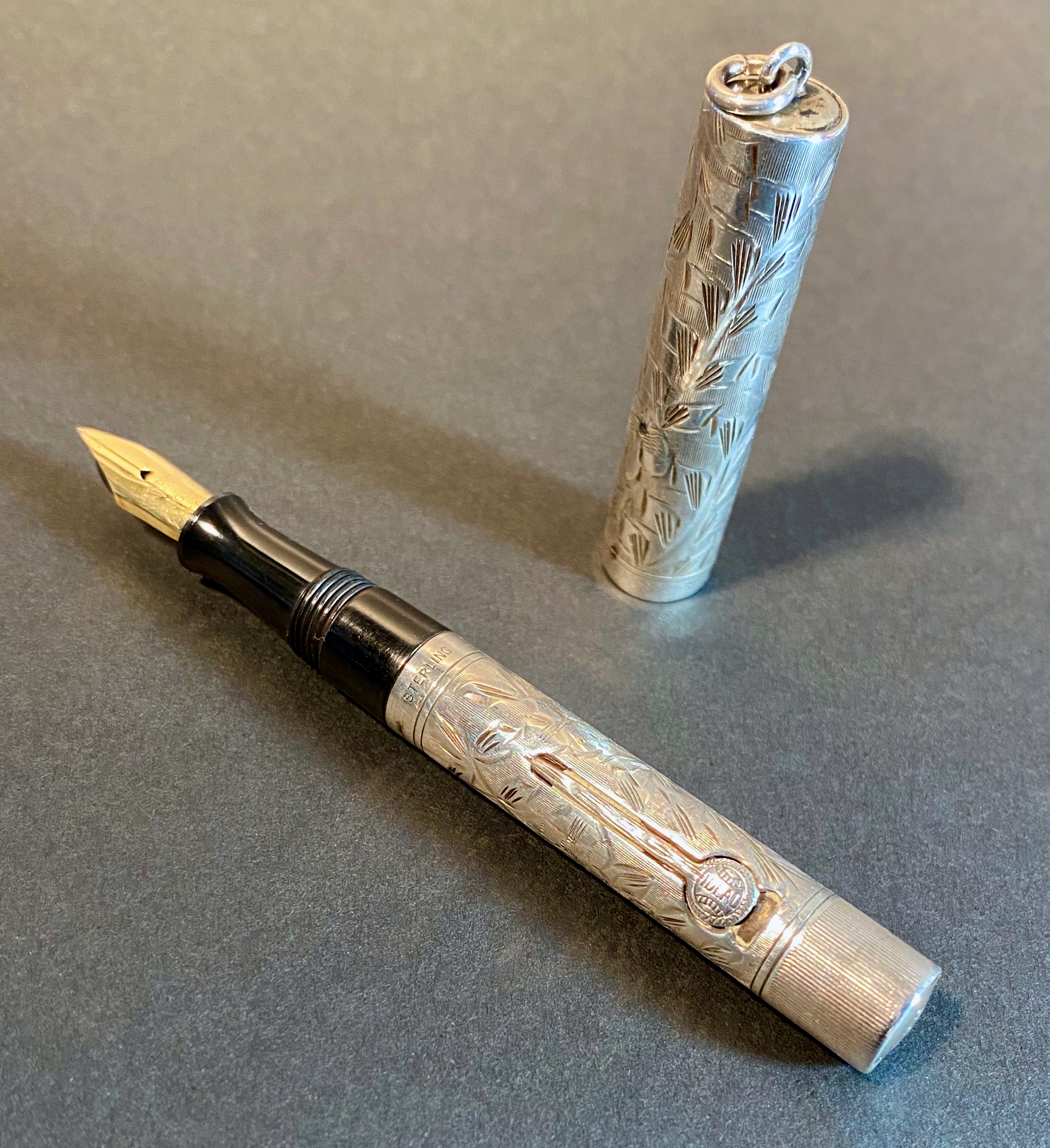

Title: Engraved Sterling Silver Antique Luxury Accessory Fountain Pen
Shipping: $29.00
Artist: N/A
Period: 20th Century
History: Art
Origin: North America > United States
Condition: Very Good
Item Date: N/A
Item ID: 489
This is a beautiful hand-engraved sterling silver antique luxury accessory fountain pen from the early 20th century, which is highly collectible. It features a gold nib and is marked Watermen's REG. U.S. PAT. OFF. Fountain Pen (U.S.A.) - Sterling Silver, Hand Engraved, Lever Filler. It is designed to be worn as a decorative piece of jewelry, hanging around the neck. The baseball logo design company Ideal 452 1/2V is marked on the end. The condition of the pen is excellent, and it measures 5 inches when laid end to end. When the cap is screwed on, the size is 3 1/2 inches. Type Vintage lever-filling fountain pen. Product Name "452 1/2 V" (stamped on barrel end, small ring-top ladies' model). Manufacturer and Year Waterman, made in USA - 1920s Length 3-5/8", capped and not including the ring-top hardware. Filling System Lever filler. Color Fully engraved sterling silver cap and barrel with floral pattern. Nib FLEXIBLE FINE Waterman's Ideal New York gold nib is smooth with nice tipping. Almost full flex. Line variation from fine to a nice broad under very little pressure, and it varies to a larger broad with a little more pressure. Condition Excellent + condition. No significant wear to the silver; no dents, dings, ripples, pitting or corrosion; only slight scratches. No cracks, chips, or scratches in underlying black barrel/section pieces. No personalization. Waterman fountain pens have a rich history that dates back to the late 19th century. The company was founded by Lewis Edson Waterman, an insurance salesman who was frustrated with the unreliability of the fountain pens available at the time. In 1883, he invented the first practical fountain pen, which used a capillary feed system to regulate the flow of ink. Waterman's invention was a breakthrough in the world of writing instruments, as it allowed for a consistent and reliable flow of ink, without the need for frequent dipping or refilling. This innovation quickly caught on, and Waterman's fountain pens became highly popular in the United States and Europe. Over the years, Waterman continued to innovate and improve its fountain pens, introducing features such as the first retractable nib in 1905 and the first lever-filling mechanism in 1913. Waterman also became known for its stylish and elegant designs, which made its pens highly sought after as luxury accessories. During World War II, Waterman's factories were repurposed for military production, but the company bounced back after the war and continued to produce high-quality fountain pens for many decades. In the 1950s and 1960s, Waterman introduced several new models, including the "C/F" (Cartridge Fountain Pen) in 1953, which was the first fountain pen to use disposable ink cartridges. In the 1980s and 1990s, Waterman continued to innovate with new materials and designs, such as the "Man 100" fountain pen, which featured a solid gold nib and a unique, hexagonal shape. Today, Waterman is owned by the Newell Brands company, and its fountain pens remain popular among collectors and writing enthusiasts around the world.
The fountain pen is a writing instrument that uses ink stored in a reservoir and delivered through a nib onto paper. The origins of the fountain pen can be traced back to ancient times when people used hollow reeds or quills to write. However, the modern fountain pen as we know it today was developed in the 19th century. The first practical fountain pen was patented in 1827 by Petrache Poenaru, a Romanian inventor. It was a crude device that used a swan quill as a reservoir for ink, and a nib made of gold. However, the modern fountain pen was not widely used until the 1880s when Lewis Waterman invented a more reliable pen that prevented leaks and blots. Waterman's pen used a capillary feed system that allowed ink to flow smoothly onto paper, and he also invented a mechanism that prevented ink from leaking from the pen. This made fountain pens more practical for everyday use, and they quickly became popular among writers and businessmen. In the early 20th century, many companies started producing fountain pens, and they became a symbol of status and luxury. Famous writers such as Mark Twain, Ernest Hemingway, and John Steinbeck were known to use fountain pens. However, the popularity of fountain pens declined with the introduction of ballpoint pens in the 1940s, which were cheaper and more convenient to use. Today, fountain pens remain popular among collectors, calligraphers, and those who appreciate the art of handwriting.